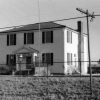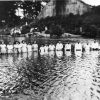calsfoundation@cals.org
Two Bayou Methodist Church
The Two Bayou Methodist Church and Cemetery are located near Camden (Ouachita County). The oldest marked graves in the cemetery date to 1846, and the church was constructed around 1875. The site was added to the National Register of Historic Places on July 9, 1998.
The first church services at the location were held under brush arbors well before the Civil War. A log building offered worshippers a more permanent structure but was destroyed during the war. Another log building was used by the congregation until the construction of the current building by J. T. Mendenhall in 1875. The congregation was served by various circuits over the decades. Research indicates that services held prior to 1848 were likely part of a circuit based in Camden. Methodist records list the church as being active in 1864. Dropped from the local circuit in 1942, the church continued operations for a few more years. When regular services ended in the early 1950s, a board took over the management of the property. The board hosts an annual homecoming each September and is responsible for the upkeep of the grounds. The name of the church is shared with the surrounding community of Two Bayou.
Located at the end of a gravel county road several miles southwest of Camden, the site consists of the single-room church building, the cemetery, and two privies. The church rests on un-mortared stone piers and is topped with a gabled roof now covered by composition shingles. Facing west, the church is accessed by two single-leaf doors. Each door is reached from the group by a set of wooden steps with a metal handrail. The north and south sides of the church include four evenly spaced four-over-four windows with wood frames. Two more of these windows are present on the rear of the building. The church includes some Greek Revival details, including a wide band of trim under the gable and the slight pediments over the two doors.
The interior of the church is plain in design, with wide wooden floorboards; wood planks cover the walls. The pews in the church were originally located in the Camden Opera House and were taken to the church in the 1920s. The pews are arranged with full pews in the center of the building and shorter pews attached to both the north and south walls, creating two aisles. A brick fireplace, wooden pulpit, and piano are also present.
Near the church is the cemetery. The earliest marked graves are for Lucius and Julius Greening, who both died in 1846. At the time of the church’s nomination to the National Register, a total of 182 graves were in the cemetery, with 120 dating before 1948 and the remaining sixty-two after that year. Several of the graves have headstones designed by J. Jennings, who also designed several stones in Oakland Cemetery in Camden. Since the nomination, additional graves have been added to the cemetery, including one in 2017. The two privies are located behind the church, although few details are available on their construction.
With very few minor changes made to the church in the years after construction, the building in the twenty-first century continues to appear much as it did when it was in active use. It remains a good example of a rural church in the state constructed in the late nineteenth century.
For additional information:
“No Preaching at Two Bayou Methodist Church.” Camden News, December 6, 1951, p. 1.
“Two Bayou Methodist Church.” National Register of Historic Places registration form. On file at Arkansas Historic Preservation Office, Little Rock, Arkansas. Online at http://www.arkansaspreservation.com/National-Register-Listings/PDF/OU0079.nr.pdf (accessed June 17, 2020).
David Sesser
Henderson State University
 Architectural Styles
Architectural Styles Historic Preservation
Historic Preservation Post-Reconstruction through the Gilded Age, 1875 through 1900
Post-Reconstruction through the Gilded Age, 1875 through 1900 Religion
Religion Two Bayou Methodist Church
Two Bayou Methodist Church 




Comments
No comments on this entry yet.